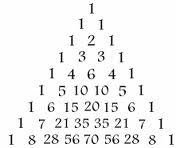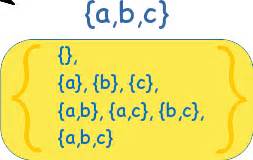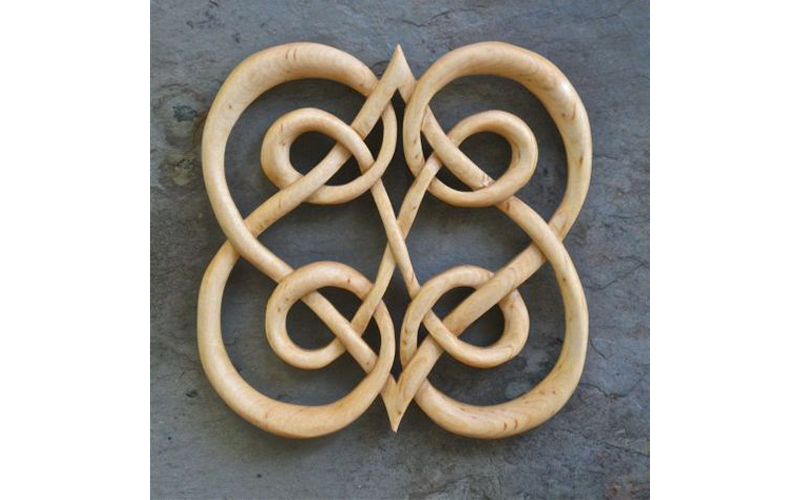- Our quiz: returned. Sorry for the delay!
- Several of you haven't submitted your one-paragraph description of your
project and a one paragraph description of your logo. Get me
that pronto, or your grade on these will suffer....
- Thursday's quiz will be over knot/link identification (can you draw any of our knots or links?), as well as Hilbert's Hotel.
- We practiced a method for exhaustively concluding whether a
knot is tricolorable or not: you try to continue with one color
as long as possible, and then, if that fails (leads to
non-tricolorability), switch to a second color -- and then you
can often "follow your nose" to discover whether the knot or
link is tricolorable or not.
- Then we started our adventure at Hilbert's Hotel: where they'll
always leave a light on for you, and they can accomodate you
even if the hotel is full!
- Speaking of Hilbert, he's in the news! This from the April 14, 2025 Scientific American: Mathematicians Crack 125-Year-Old Problem, Unite Three Physics Theories: A breakthrough in Hilbert's sixth problem is a major step in grounding physics in math.
- A review of some key ideas:
- Infinity is NaN: Not a Number
Natural numbers are things which have a size, and if you add one to a natural number, you get a bigger number.
You don't get "a bigger number" -- more hate -- when you hate someone "infinity plus one".
In part because you don't have a number to begin with; but trying to add a number (1) to NaN doesn't work to give you a bigger number.
- Infinity is NaS: Not a Size, either! The reason is that there
is more than one size of infinity! This is the most
important thing I want you to remember. (This fact will allow
you to win on the playground!;)
- The natural numbers are infinite in number (the size of the set is
larger than any natural number). It is called a countable
infinity, because, well, we can start counting it! (We just
never get to the end).
- What is Cardinality? It is the way that we measure
infinite sets:
- Two sets have the same cardinality if there is a one-to-one correspondence between them.
Intuitively: We will say that two sets have the same size if they have the same cardinality.
- Infinity is NaN: Not a Number
- Last time we began our study of "The Hilbert Hotel". The Hilbert Hotel
has natural numbered hotel rooms -- there's an infinite number
of rooms, labelled 1, 2, 3, 4, .... for every natural number.
- The place is packed, and one person shows up;
One-to-one correspondence: \(\mathbb{N} \to \{2,3,4,\ldots,n,\ldots\}\), by \[ n \to n+1 \]
This result informs us that when someone on the playground hollers "I hate you infinity plus 1!", they really haven't hated any more than a simple infinity.
Alternatively, if your lover says they love you infinitely much, you can't impress them by saying that you love them infinitely plus one. They will scoff, and perhaps leave you for a better mathematician! So take note....
- The place is packed, and an infinite school bus shows up.
One-to-one correspondence: \(\mathbb{N} \to \{2,4,6,\ldots,2n,\ldots\}\), by \[ n \to 2n \] We send the people in their rooms to twice their room number.
Then we slide the students on the bus into rooms \[ n \to 2n-1 \]
One-to-one correspondence: \(\mathbb{N} \to \{1,3,5,\ldots,2n-1,\ldots\}\).
This result informs us that when someone on the playground hollers "I hate you 2*infinity!", they really haven't hated any more than a simple infinity.
The natural numbers have the same cardinality as the set of even natural numbers, and the same cardinality as the set of odd natural numbers.
- The place is packed, and an infinite number of infinite
school buses show up! (Buses numbered 1, 2, .... with
seats labelled 1, 2, ....)
One-to-one correspondence: Each bus gets mapped to a prime number \(\mathbb{N} \to \{2,3,5,\ldots,p_n,\ldots\}\), so that the bus \(m\), \(B_m\), gets mapped to the \(m^{th}\) prime number: \[ B_m \to p_m \] Then the kids on bus \(B_m\) get mapped to powers of that prime: \[ n \to p_m^n \]
Because of the prime factorization theorem, which says that every natural number (other than 1) is either prime, or can be written as a product of primes in a unique way, we know that two students cannot be assigned to the same room number. If so, we would have two different prime factorizations of the same number, i.e.
\[ p_r^s=p_m^n \]
But since prime factorizations are unique, and so that can't happen, every student has their own private room. I hope that the chaperones are ready for this! :)
This result proves that there are just as many rational numbers (ratios of integers, of the form \(\frac{m}{n}\)) as there are natural numbers.
- The place is packed, and one person shows up;
- But if a bus containing the irrational numbers shows up -- now
there's an infinite set! It's too big for the
hotel...:( Finally the Hilbert Hotel meets its match!
The real numbers (containing both the rational and irrational numbers) is just too big for Hilbert's Hotel. Mathematicians' guts lead them to believe (generally) that the real numbers are the next largest infinity (the first "uncountable" one).
Let me try to convince you of that, in the following way (called "Cantor's diagonalization argument"):
- Assume that all of the real numbers have found a room at Hilbert's Hotel -- i.e. that there exists a one-to-one correspondence between the natural numbers and the real numbers.
- We'll produce a real number that doesn't have a room. I.e., we'll contradict the assumption, and show that there isn't a one-to-one correspondence.
- We'll do that by constructing a real number that is clearly different from every number on the list of occupants at the hotel.
- The upshot: this means that the natural numbers and the real numbers are not the same size, and that the real numbers are simply too numerous for Hilbert's Hotel.
- The natural numbers have cardinality \(\aleph_0\), and the real numbers have cardinality \(\aleph_1\) -- the next bigger infinity.
Let me show you how.....
- The Hilbert Hotel shines a light on a strange fact about infinity:
that when you get to sets that are infinitely sized, you find
that their subsets can be exactly the same size as they
are. This is very strange, and doesn't work with finite
sets. So it's a very mysterious property for those of us
accustomed to working with finite things....
- Here's the upshot of what Cantor discovered:
- Some mathematical facts:
- Mathematical facts zero:
- A set \(S\) is just a collection of objects; and a
subset of \(S\) is just what you'd expect: some members of
\(S\).
- It may be all the members, in which we call it an "improper" subset (that is \(S\) is a subset of itself); or
- it may be none of them (in which case we call it the empty set, denoted \(\{\}\) or \(\emptyset\)).
We often denote a set by using braces, e.g. \(S=\{1,2,3\}\) is the set of the first three natural numbers. Thus we would say that \(S\) is a subset of the natural numbers \(\mathbb{N}\), and we denote it \(S \subseteq \mathbb{N}\).
We say that \(a\) is an element of \(S\) if \(a\) is contained in \(S\), and we write \(a \in S\). So \(1 \in S\), \(2 \in S\), and \(3 \in S\). We deny that an object is in \(S\) this way: \(4 \notin S\).
Thus for every set, \(S \subseteq S\) and \(\{\} \subseteq S\).
- Mathematical fact one:
- A subset is never bigger in size than the set itself.
And if the sets are finite, the proper subset is always smaller, but if the set is infinite, we may actually be able to throw away elements of a set and not change the size of the set!
- Mathematical fact two:
- Let's call the set of all of a set S's subsets its
power set, \(P(S)\). Pascal's triangle (that rascal!)
shows you how many of each type of subset you have (for finite
sets). Let's look at "line 3" (that is, 1 3 3 1):

It's about how many ways we have of choosing \(r\) things from \(n\), right? That's exactly what a subset of \(r\) elements is: a choice of \(r\) things from \(n\). Here are the four different groups of subsets represented by that line:

- Mathematical fact three:
- The power set of a set of $n$ elements contains $2^n$
elements.
Imagine that each of the \(n\) elements is a person, who decides if they're going to stand up and join a subset, or not. Each person has two choices, and they make them independently. Thus we have \(2 \cdot 2 \cdot \ldots 2\) -- \(n\) times -- ways of making a choice of a subset, of choosing.
(We know that since each row of Pascal's triangle adds to a power of 2, and the elements in each row represent all the different subsets of each size possible, from 0 up to \(n\).)
- Mathematical facts zero:
- Even the set containing no elements has one subset -- the set
itself. So the power set has one element -- has size bigger
than the set itself.
This property holds true for all finite sets -- and it turns out to be true for infinite sets, too!
Here's a silly video to illustrate how the power set grows with sets of increasing size. (Thanks to Dr. Towanna Roller (Asbury University) and her daughter Kristyn Roller (UK) for this one!)
- This means that, although the natural numbers $1,2,3,\ldots$ is
infinite as a set, there's a bigger set (the power set of the
natural numbers).
And the power set of that set is bigger yet, and so on forever, forever, Hallelujah, Hallelujah!
-
Upshot: infinity comes in various sizes! Infinitely
many, in fact. Crazy sounding, I know -- but it's true.
That symbol that you've been familiar with for all your lives, $\infty$: you thought it stood for a single thing; but it stands for a whole collection of monstrously big things, all too big to really think about properly. (Well, Cantor did!:)
- That's too crazy, it seems; but, nonetheless, mathematicians
know that it's true, because we can prove it! The key to
determining if two sets have the same size is the one-to-one
correspondence -- and that is key for infinite sets, as well.
- So, in the end, here's what you say on the playground,
when you want to love your friend more:
"I love you more than the power set of your set of infinite love."

Amen!
- Some mathematical facts:
- My collection
of knots and links
- My Borromean knots (and links)
- Tricolor These Handout: just two of the knots/links are not tricolorable; all the rest are!
- A much more thorough introduction to both Reidemeister moves and tricolorability is in this article: Tricolorability of Knots, by Kayla Jacobs.